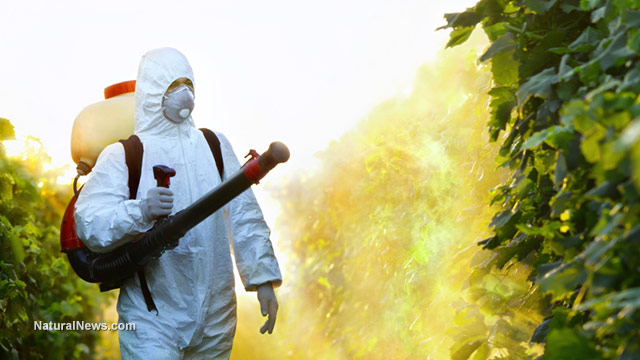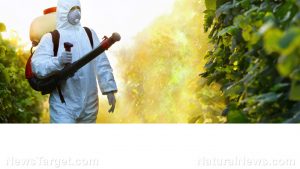
Myclobutanil — toxicity, side effects, diseases and environmental impacts
Thursday, November 23, 2017 by Zoey Sky
http://www.naturalpedia.com/myclobutanil-toxicity-side-effects-diseases-and-environmental-impacts.html

Myclobutanil is a conazole class fungicide, and it is used heavily to control fungi that affect wine and table grapes. The fungicide is mostly used in California, and it also has various food crop and commercial or residential landscaping applications.
Myclobutanil appears as a white crystal solid. It is mobile in soil and has a solubility in water of 142 milligrams per liter (mg/L). Myclobutanil is commercially available as granular dust, dry flowable, and ready-to-use formulations.
The state of California accounts for almost 50 percent of all myclobutanil use in the United States, using 70,000 to 90,000 pounds (lbs.) yearly. At least 60 percent of all myclobutanil in California is used for grapes. The fungicide is also used on almonds and strawberries grown in California.
Myclobutanil is also known as C446685, HOE 39304F, MFCD00144818 (MDL number), Eagle, Masalon, Nova, Nova (pesticide), Nova W, Nu-Flow M, Rally, RH-3866, Synthane 12E, Systhane 20 EW, systhane, SYSTHANE 6 FLO.

List of known side effects
Myclobutanil is harmful if swallowed, and it can cause serious eye irritation. It is also suspected of damaging fertility or the unborn child. Prolonged or repeated exposure to myclobutanil can cause damage to the organs. Myclobutanil is toxic to aquatic life, with long-lasting effects.
Myclobutanil is highly toxic and may be fatal if inhaled, swallowed, or absorbed through the skin. The effects of contact or inhalation may be delayed.
Body systems affected by myclobutanil
There is little to no information regarding the human exposure effects of the fungicide myclobutanil. While it has a low acute toxicity, myclobutanil can affect the reproductive abilities of test animals.
It has been noted that it can irritate the human respiratory system once inhaled (oral mucosal irritation, nausea, vomiting, coughing, or bronchospasm). Myclobutanil can also have negative side effects on the digestive (diarrhea), integumentary, ocular, and reproductive systems.
Myclobutanil can cause severe caustic effects or burns, and manifestations might include persistent vomiting, stridor, drooling, pain with or inability to swallow, and abdominal pain. Upper airway edema, stridor, and severe bronchospasm can also develop. Eye or skin exposure can cause severe irritation and burns.
The fungicide can cause narcosis ranging from somnolence to coma. Myclobutanil can disrupt metabolic processes such as inducing hypoglycemia, uncoupling oxidative phosphorylation, inducing metabolic acidosis, causing methemoglobinemia, causing electrolyte abnormalities, etc.
Items that can contain myclobutanil
Myclobutanil is a fungicide used to control Ascomycetes, Fungi Imperfecti, and Basidiomycetes in all sorts of crops like table grapes. The fungicide is used to control pests powdery mildew, dollar spot, summer patch, brown patch, rusts, and scab.
Myclobutanil is applied on perennial and annual crops, turf, landscape ornamentals, fruit trees, and vines. The fungicide is also often supplied as an oil suspension in water mixed with water and used as a spray.
How to avoid myclobutanil
When handling myclobutanil, always wear the following protective gear:
- Respirator — Particulate. Consult your Environmental Health and Safety (EHS) staff for recommendations.
- Eye — Wear safety glasses with side shields, or chemical goggles.
- Hands/feet – Wear chemical protective gloves. Suitability and durability of glove type is dependent on usage, and important factors in the selection of gloves include frequency and duration of contact, chemical resistance of glove material, glove thickness, and dexterity.
- Other — Other important items are overalls, apron, barrier cream, skin cleansing cream, and eyewash unit.
Where to learn more
- Are you smoking pesticides? Canada decides against chemical testing of medical marijuana
- Poison.news
- Chemicals.news
- Toxins.news
- Pesticides.news
Summary
Myclobutanil is a conazole class fungicide, and it is used heavily to control fungi on wine and table grapes.
Myclobutanil can irritate the human respiratory system once inhaled.
Myclobutanil is applied on perennial and annual crops, turf, landscape ornamentals, fruit trees, and vines.
Sources include:
Tagged Under: Tags: Myclobutanil





